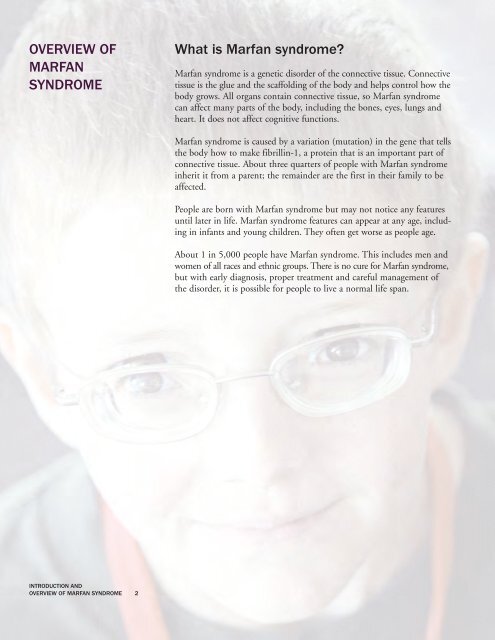Marfan Syndrome:
Marfan Syndrome:
Marfan Syndrome:
Create successful ePaper yourself
Turn your PDF publications into a flip-book with our unique Google optimized e-Paper software.
OVERVIEW OF<br />
MARFAN<br />
SYNDROME<br />
INTRODUCTION AND<br />
OVERVIEW OF MARFAN SYNDROME 2<br />
What is <strong>Marfan</strong> syndrome?<br />
<strong>Marfan</strong> syndrome is a genetic disorder of the connective tissue. Connective<br />
tissue is the glue and the scaffolding of the body and helps control how the<br />
body grows. All organs contain connective tissue, so <strong>Marfan</strong> syndrome<br />
can affect many parts of the body, including the bones, eyes, lungs and<br />
heart. It does not affect cognitive functions.<br />
<strong>Marfan</strong> syndrome is caused by a variation (mutation) in the gene that tells<br />
the body how to make fibrillin-1, a protein that is an important part of<br />
connective tissue. About three quarters of people with <strong>Marfan</strong> syndrome<br />
inherit it from a parent; the remainder are the first in their family to be<br />
affected.<br />
People are born with <strong>Marfan</strong> syndrome but may not notice any features<br />
until later in life. <strong>Marfan</strong> syndrome features can appear at any age, including<br />
in infants and young children. They often get worse as people age.<br />
About 1 in 5,000 people have <strong>Marfan</strong> syndrome. This includes men and<br />
women of all races and ethnic groups. There is no cure for <strong>Marfan</strong> syndrome,<br />
but with early diagnosis, proper treatment and careful management of<br />
the disorder, it is possible for people to live a normal life span.


